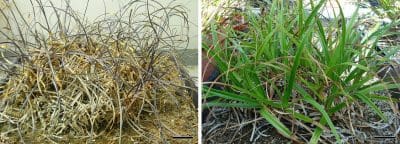SCIENTISTS have taken an important step towards developing crops with the capacity to withstand and recover from drought.

Xerophyta viscosa plants, dried for 25 days until less than five per cent relative water content (left) and after five days of watering (right).
The international consortium of researchers, including researchers from the Queensland University of Technology (QUT), have sequenced the genome of the ‘resurrection plant’, Xerophyta viscosa, revealing a genetic ‘footprint’ of the plant’s ability to tolerate severe drought for long periods of time.
The research team is led by Henk Hilhorst of Wageningen University and Research in the Netherlands and includes QUT researchers Professor Sagadevan Mundree and Dr Brett Williams as well as other researchers from the Netherlands, South-Africa and the United States.
The team hopes their results will contribute to the faster development of food crops that are resilient enough to cope with foreseen global climate changes.
The consortium chose to study the plant, which is a native of southern Africa, because of its amazing capability to survive complete drying.
Research leader Henk Hilhorst said food crops that could survive extreme drought were, and would be, of increasing importance.
“Climate change causes longer and extremer periods of drought, while at the same time the growing world population demands a dramatic increase of food production,” he said.
“Resurrection species like Xerophyta viscosa may serve as ideal models for the ultimate design of crops with enhanced drought tolerance.”
The team studied changes in gene expression patterns during dehydration, in order to find genes which enabled the plant to survive desiccation.
QUT Centre for Tropical Crops and Biocommodities director, Professor Sagadevan Mundree, said his team’s work, which revealed how a native Australian grass could be brought back from the ‘dead’, made QUT researchers ideal partners for this project.
“During periods of extreme dryness the Australian grass, Tripogon loliiformis, goes through a similar process of dessication in which autophagy is triggered, a process by which the plant degrades and recycles its own contents,” he said.
“The plant constantly removes damaged proteins and toxins while recycling nutrients and this prevents the plant leaf tissue from dying.”
Source: QUTre
The DNA sequence of the ‘resurrection plant’ is published in Nature Plants. The paper is available at: http://dx.doi.org/10.1038/nplants.2017.38

HAVE YOUR SAY